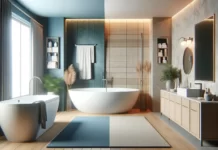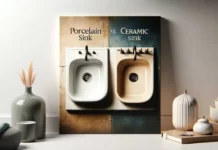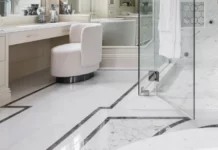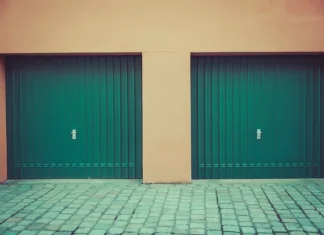Looking at old tiles in the bathroom or kitchen may be depressing and it can make you feel out of touch with the trends. This feeling can have a negative impact on your mental health as well as your personal or professional growth, but removing tiles is not a simple process.
The most difficult aspect of a bathroom or kitchen makeover is changing the tiles, which consumes the majority of your funds as well as your time and work. So, here are a few quick fixes that are both cost-effective and labor-intensive.
When looking for a solution, it is important to consider whether it is waterproof. Showers and sinks produce a lot of humidity and wetness, so you’ll need something that can handle it.
So, what can we do to cover tiles without removing them? Here is just a brief rundown to give you an idea of what’s in trends. Keep reading for more details about each solution.
Ways to Cover Wall Tiles Without Removing Them
1. Paint Tiles
If you’re weary of your home’s color scheme or the tiles have started to appear old and dingy, here’s an easy and affordable fix, paint them. Waterproof tile paint, created explicitly for bathrooms, is an easy fix to cover bathroom tiles without removing them.
There are textures like glossy, satin, and matte to choose from, depending on your preference or the needs of your space. In case of kitchen or bathroom tiles, the number of choices is very limited for preventing mold growth in the grout.
2. Wall Panels
Vinyl is a cost-effective, time-saving, and long-lasting option for covering bathroom tiles. Wall panels with a tile look that is constructed of PVC and are completely waterproof. They may be utilized in a variety of locations throughout the house, including the shower enclosure, bathroom, laundry room, and even the kitchen.
Covering tiles with vinyl is a quick, easy, and long-lasting option that is cost-effective, time-saving, and very durable. PVC wall panels with a tile-like appearance that are entirely waterproof. They may be used in a multitude of places throughout the house, including the shower, bathroom, laundry area, and even the kitchen.
3. Quick setting Cement
One other option for covering tiles is to use quick-setting cement, which is sometimes called fast-setting cement. This is a unique type of cement that has been carefully engineered to set in as little as 10-15 minutes. It is mostly used to quickly shape objects as needed. It’s also an effective way to cover your bathroom tiles. It’s a labor-intensive job, but if you use the correct concrete sealant, it can be done for a reasonable price.
This type of cement is typically utilized in underwater construction and cold-weather concreting. It may also be used to fix existing structures without causing them to move. Even though it sets faster than Ordinary Portland Cement (OPD), it has the same strength and durability. It has high water resistance and only needs a small amount of water to stay hydrated.
4. Beadboard – Something More Unconventional
It’s a classic wood-strip wall paneling design that’s commonly used as wainscoting in kitchens and dining rooms, but it may also be utilized in bathrooms. Obviously, some precautions must be taken prior to installation, such as pre-treating the beadboard with waterproof paint. Finish the installation by grouting the margins to ensure that it is totally moisture-free. Keep in mind that if moisture gets trapped between the board and the wall, the structure will be damaged and entirely weakened.
You may buy huge sheets of beadboard and paint them anyway you like or according to your bathroom’s needs for installation. After that, just measure and cut the board to fit the tile area to be covered and apply a thick coating of liquid nail glue to the existing tiles and slowly push the board in place.
5. Wallpapers and Wall Stickers
This one is very simple and very effortless. Because that is precisely what it is, it is as simple as pasting labels. Wallpaper stickers are a quick and easy way to give your bathroom or kitchen a new look.
One thing to keep in mind if you choose this approach is that not all wallpapers are acceptable for bathrooms. Wallpapers for the bathroom are different from other areas. For specific bathrooms choose one that is designed for high moisture content and is thus the best fit for your bathroom. Modern designs and deeper colors are more suited to the area like the dining room or living room, although there are numerous possibilities to choose from.
6. Attach Waterproof Wall Panels
Shower wall panels are water-resistant panels that may be installed around a sink, shower, or bath. These tile substitutes are available in a number of sizes and may be cut into any form. Shower wall panels are easy to install and, unlike tiles, do not require grouting. This makes them simple to keep clean. To keep the panels appearing new, all you have to do is wipe them down. These panels work well in both classic and contemporary bathrooms, and because they come in both modern and traditional designs, they may be used in any bathroom decor.
Slate, marble, stone, or even marble as a high-end material choice is used to create wall panels. Acrylic stone or moisture-resistant MDF are used for the less expensive materials. To improve its look, some panels include components such as glitter. Regardless of the material you select, all of the panels are colorfast and long-lasting.
7. Hang An Attractive Shower Curtain
If painting your tiles or adding a liner isn’t an option, you might want to consider hanging a simple shower curtain to disguise the old tiles. This option is particularly well suited to renters who do not want to spend a lot of time or money covering unsightly shower tiles. A stylish shower curtain will dress up your bathroom while keeping the old tiles hidden in the background.
A water-resistant patterned shower curtain can add a lovely touch to your bathroom while concealing those unsightly tiles, giving it a fresh new look quickly and effortlessly. This machine-washable curtain is composed of mold and mildew-resistant polyester material for long-lasting use. A weighted bottom hem, as well as 12 plastic hooks and rustproof metal grommets, keep the curtain in place.
Our take:
The question of how to cover bathroom wall tiles without removing them depends on what is the function of the tile. If it is just decorative, and not being used as a moisture-resistant wall finish, you have a few options. If by cover up you mean actually overlay them with another wall finish or to actually change the whole look. Whatever your requirement is, this article will surely give you enough ideas to cover it up.












